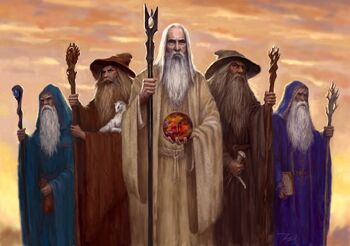
The five wizards
The Wizards, initially known as the Istari, were five Maiar spirits sent to Middle-earth as human forms to aid the Free Peoples against the threat of Sauron.
History
In the Undying Lands around TA 1000, Manwë became aware that the spirit of Morgoth's most dedicated lieutenant Sauron was rising in power again, and summoned a council of the Valar to send three messengers to Middle-earth to protect the free peoples and assure them the Valar had not forgotten them. Two Maiar came: Curumo (or Curunir; later known as Saruman) sent by Aulë, and Alatar (Morinehtar), sent by Oromë. Manwë asked where Olórin (later known as Gandalf) was, and he came, after returning from a journey. Manwë asked Olórin if he would go as the third messenger. Olórin said he was too weak and that he was afraid of Sauron; however, Manwë said that was all the more reason to go, and that he commanded Olórin to go as the third. Then Varda said "Not as the third." Yavanna begged Curumo to take Aiwendil (Radagast), and Alatar took Pallando (Rómestámo) as a friend. They were forbidden to dominate the free peoples of Middle-earth or to match Sauron's power with power. When Saruman, the greatest of the Wizards, disobeyed this injunction, he was cast from the order and banished from ever returning to Valinor.
The Wizards were known by various names, and were arrayed in different colours. Of those who came to Middle-earth, sent by the Valar, five are known, the Heren Istarion (Order of Wizards). After arriving in Middle-earth, the two Blue Wizards apparently went east before the War of the Ring; whether they played a part in the events of that war is unknown. (Note: According to Tolkien's letters they may have formed cults for magic worship and practice among the Easterlings.) Radagast the Brown concerned himself mainly with plants and animals, and lived in Mirkwood for many years. Saruman the White and Gandalf the Grey spent time with the Free Peoples: the Elves, Dwarves, and Men. Saruman was wise and respected and became head of the White Council in TA 2463. However, he became prideful and jealous of the potential and purity of spirit of Gandalf, who would eventually surpass him in power. Saruman slowly came to betray the original purpose of the Wizards, and sought power for himself. He was overthrown during the War of the Ring, by his tormented servant, Grima Wormtongue. Grima slit Saruman's neck after a failed attempt to rule the Shire. Saruman's spirit looked to the West and Valinor, but was blown away.
At the end of the Third Age, the Wizards passed from sight; since, with the fall of Sauron, their work was done. Gandalf passed over the Sea with the Last Riding of the Keepers of the Rings. Saruman became a naked spirit and wandered Middle-earth forever, since he was banished from Valinor. Radagast stayed in Middle-earth, tending to the wilderness. The fate of the Blue Wizards is unknown.[citation needed]
Appearance
The wizards bore the forms of old Men; they were ancient and seemed to age very fast. They possessed great skill of body and mind; the greater portion of their power as Maiar resided in their staffs. Each of the Istari had his own colour and grade within the Order. Saruman the White was the eldest and Gandalf the Grey second. The other Istari were Radagast the Brown and the two Blue Wizards, who dwelt far in the east.
Etymology
Istari is a Quenya word[1] (singular Istar). The Sindarin translation is Ithryn (singular Ithron).
Named wizards
- Curumo, the White Wizard, was more commonly known as Saruman. However, after being seduced by the evil power of Sauron, Saruman became the Many-Coloured Wizard.
- Saruman (human form) was killed by Gríma Wormtongue following the Battle of Bywater, and Gandalf returned to the Undying Lands in TA 3021. However, the fates of the three other Istari are relatively unknown. Alatar and Pallando disappeared in the east, while Radagast stayed in Middle-earth until at least TA 3018.
- Olórin, the Grey Wizard, was more commonly known as Gandalf. However, after dying at the hands of a Balrog, Durin's Bane, Gandalf was reborn as the new White Wizard.
- Aiwendil, the Brown Wizard, was more commonly known as Radagast. Radagast was a lover of nature and so did not play any major part in the War of the Ring except for announcing to the Great Eagles that Gandalf was at the Orthanc with Saruman.
- Alatar and Pallando, the Blue Wizards. (Note: Later in his life, Tolkien wrote a note, suggesting that the names of the Blue Wizards were Morinehtar and Rómestámo. It is not clear whether these names were intended to replace the names Alatar and Pallando, or whether Morinehtar and Rómestámo were alternate names for the Blue Wizards, possibly those given to them by the peoples of Middle-Earth.)
| The Wizards | |||
|---|---|---|---|
| Middle-earth name | Colour | Maia name | Belongs to |
| Saruman | White (later of Many Colors) | Curumo | Aulë |
| Gandalf | Grey (later White) | Olórin | Manwë and Varda |
| Radagast | Brown | Aiwendil | Yavanna |
| Morinehtar | Blue | Alatar | Oromë |
| Rómestámo | Blue | Pallando | Oromë |
Gallery
 |
 |
 |
| File:Gandalf; The Grey.jpg |
 |
 |
Translations around the World
| Foreign Language | Translated name |
|---|---|
| Afrikaans | Ghoeroes |
| Albanian | Magjistarët |
| Arabic | السحرة |
| Armenian | Վիզարդզ |
| Azerbaijani | Sehrbazlar |
| Basque | Morroiak |
| Belarusian Cyrillic | Чараўнікі |
| Bengali | উইজার্ডস |
| Bulgarian Cyrillic | Магьосници |
| Catalan | Mags |
| Cebuano | Mga salamangkero |
| Croatian | Čarobnjac |
| Czech | Čarodějové |
| Danish | Troldmænd |
| Dutch | Tovenaars |
| Esperanto | Sorĉistoj |
| Estonian | Võluriteks |
| Filipino | Mga salamangkero |
| Finnish | Velhot |
| French | Sorciers |
| Galician | Asistentes |
| Georgian | ჯადოსნები |
| German | Zauberern |
| Greek | Μάγοι |
| Gujarati | વિઝાર્ડઝ |
| Hindi | जादूगर |
| Hebrew | הקוסמים |
| Hungarian | Varázslók |
| Icelandic | Töframenn |
| Indonesian | Penyihir ? |
| Irish Gaelic | Draíodóirí |
| Italian | Stregoni |
| Kannada | ವಿಸರ್ಡ್ಸ್ |
| Kazakh Cyrillic | сиқыршылар |
| Korean | 마법사들 |
| Kyrgyz Cyrillic | Уизардс |
| Laotian | ຂອງຄວາມຍາວປາ |
| Latvian | Burvji |
| Lithuanian | Vedliai |
| Macedonian Cyrillic | Визардс |
| Malagasy | Mitsiatsiaka |
| Maltese | Sħaħar ? |
| Marathi | विझार्ड्स |
| Mongolian Cyrillic | Мэргэ төлөгчид ? |
| Nepalese | विजार्डहरू |
| Norwegian | Trollmenn |
| Pashto | سروکاران ? |
| Persian | جادوگران |
| Polish | Czarodzieje |
| Portuguese | Feiticeiros |
| Punjabi | ਵਿਜ਼ਡਾਰਡਸ |
| Romanian | Vrăjitori |
| Russian | Волшебники |
| Samoan | Taulaitu |
| Serbian | Чаробњаци (Cyrillic) Čarobnjaci (Latin) |
| Slovenian | Čarovniki |
| Somalian | Saaxiriinta |
| Spanish | Magos |
| Swahili | Wachawi |
| Swedish | Trollkarlar |
| Tajik Cyrillic | ҷодугарон |
| Tamil | விசார்ட்ஸ் |
| Telugu | విజార్డ్స్ |
| Thai | พ่อมด |
| Tongan | Kau fie mana |
| Turkish | Büyücüler |
| Ukrainian Cyrillic | Чарівники |
| Urdu | جادوگر ? |
| Uzbek | Сеҳргарлар (Cyrillic) Sehrgarlar (Latin) |
| Vietnamese | Pháp sư |
| Welsh | Dewiniaid |
| Yiddish | וויזאַרדס |
